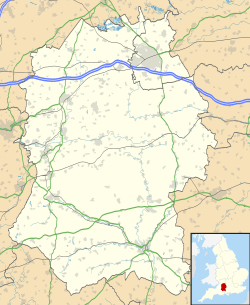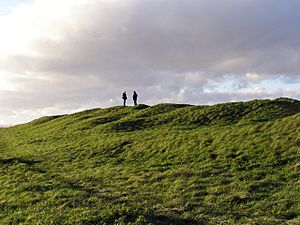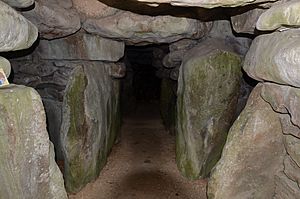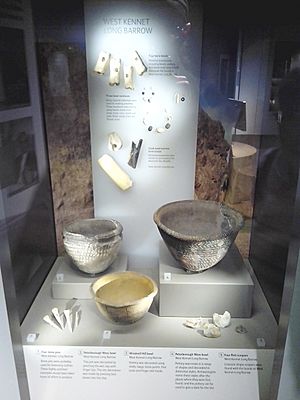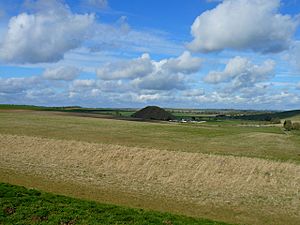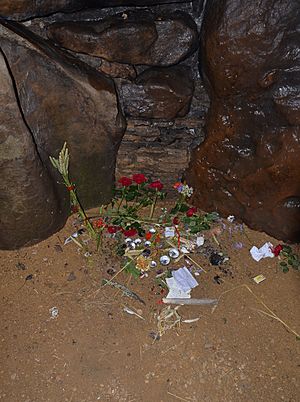West Kennet Long Barrow facts for kids
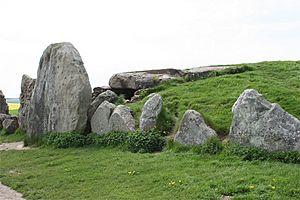
View of the outside of West Kennet Long Barrow
|
|
| Location | Wiltshire, England |
|---|---|
| Coordinates | 51°24′30.83″N 1°51′3.9″W / 51.4085639°N 1.851083°W |
| Type | Tumulus |
| Official name | Stonehenge, Avebury and Associated Sites |
| Type | Cultural |
| Criteria | i, ii, iii |
| Designated | 1986 (10th session) |
| Reference no. | 373 |
| Region | Europe and North America |
The West Kennet Long Barrow is a very old burial mound. It is near the village of Avebury in Wiltshire, England. People probably built it around 3700 BCE, during the Early Neolithic period (New Stone Age). Today, parts of it have been rebuilt to look like it did long ago.
Archaeologists believe that early farmers built this monument. These communities had just started farming in Britain. The West Kennet Long Barrow is a type of tomb called a chambered long barrow. This style of building was common across Europe in the Stone Age. It is part of a group of about 30 similar tombs found near Avebury.
The barrow is made of earth, local sarsen stones, and oolitic limestone from the Cotswolds. It has a long, rectangular shape with stone rooms inside. People placed human bones in the main chamber, likely between 3670 and 3635 BCE. These bones belonged to men, women, and children. After a break, the barrow was used again for burials between 3620 and 3240 BCE. Both human and animal remains were placed inside. People also left flint tools and pottery. Later, the entrance was blocked with large sarsen boulders.
During the Roman period, someone buried a small collection of coins in the side of the barrow. People became interested in the ruin in the 1600s. Archaeologists dug there in 1859 and again in 1955–56. After the last dig, the barrow was rebuilt. Now, English Heritage looks after it. It is part of the "Stonehenge, Avebury and Associated Sites" UNESCO World Heritage Site. Visitors can explore it for free all year.
Contents
Where is this Ancient Site?
The West Kennet Long Barrow is located near Avebury in northern Wiltshire. It sits on top of a hill, overlooking the Kennet valley.
From the barrow, you can see Avebury to the north. To the south, you can see St Anne's Hill and Wansdyke. Its high position makes it a very noticeable landmark.
Life in the Stone Age
The Early Neolithic period was a time of big changes in Britain. Between 4500 and 3800 BCE, people started farming instead of hunting and gathering. This new way of life came from Europe.
Britain was mostly covered in forests during this time. There is not much proof of crops or permanent homes. This suggests that early Neolithic people mostly raised cattle. They likely moved around a lot with their animals.
Ancient Tombs of Western Europe
In the Early Neolithic, people in Western Europe began building huge structures. These included chambered long barrows. These were long, rectangular mounds of earth with a room inside. Some rooms were made of wood, others from large stones called "megaliths".
These long barrows were often used as tombs. They held the remains of many people from a community. This tradition of building stone tombs spread from Spain to Sweden. It came to Britain around 4000 BCE. These tombs are some of the first widespread stone buildings ever made by humans.
The clearings where these barrows were built became important over time. At first, people might have used these places for living, farming, or grazing animals. But over time, these spots gathered stories and memories. Some might have even become mythical. This led to them becoming special places for rituals before the barrows were built.
Archaeologists Joshua Pollard and Andrew Reynolds noted that the area around Avebury was slowly changing. About 30 Early Neolithic long barrows are known in northern Wiltshire. Most of these had stone chambers. Others might have been destroyed by farming over thousands of years.
These tombs are spread out in an area about 20 by 15 kilometers. Avebury is near the center of this area. They are found in different places, like valleys, hilltops, or hillsides. Many were built on sites where people had already been active. This suggests people wanted to connect with the past of these places.
How West Kennet Long Barrow Was Built
The area where West Kennet Long Barrow stands was likely used by people before the tomb was built. This is shown by pottery pieces found under the monument. The style of the barrow and the burials inside it tell archaeologists it was built in the Early Neolithic.
Scientists used a method called resistivity survey in the 1960s. They found a bend in the ditches next to the barrow. This suggests the long barrow might have been built in stages. It could have started smaller and then been made larger. Other tombs, like Wayland's Smithy, also grew over time.
The Mound
The West Kennet Long Barrow is very large. It is 100 meters long and 20 meters wide. Archaeologist Timothy Darvill called its size "exceptional." Most long barrows are much smaller.
A ditch runs along each side of the monument. These ditches would have provided the earth to build the mound.
The Stone Chamber
The stone chamber inside the barrow is quite special. It is more complex than most others of its kind. The chamber is made of sarsen stones. It goes 12 meters deep into the mound.
The roof of the chamber is high, between 1.7 and 2.2 meters from the floor. This is tall enough for visitors to stand up straight. This is rare for these ancient tombs. Most chambers, like those at Belas Knap, are less than one meter high. Archaeologists think this tall space allowed people to gather inside. They might have used it to connect with their ancestors.
The builders also used oolitic limestone in the walls. This stone does not naturally occur in the area. It had to be brought from places like Frome and Bath. Perhaps it was chosen for its look or because it came from a special, distant place. It might also have linked the builders to their ancestral lands.
How the Tomb Was Used
Scientists used radiocarbon dating on bones from inside the barrow. They found that the first people buried there died around 3670–3635 BCE. This first period of burials lasted only a short time, perhaps 10 to 30 years. This suggests the barrow was built around the same time these people died.
After this first use, there was a long break, possibly over 100 years. During this time, parts of the tomb's walls started to fall apart. It seems people did not use the barrow much during this period.
A second period of burials began around 3620–3240 BCE. This phase lasted for several centuries. During this time, people covered the older burials with layers of chalk, earth, and sarsen stones. They also added more human and animal remains. Many of these remains were of young people, including infants. It is possible these bones were collected over time and then placed in the barrow all at once.
Along with the bones, people placed tools made of flint and bone. They also left many pieces of pottery. These pottery pieces came from at least 250 different pots. Some of these pots could have been made over a thousand years apart.
The End of its Use
Around 3000 BCE, large sarsen boulders and earth were used to block the entrance to the tomb. Later, three huge sarsen stones were set up across the front. This completely blocked off the chamber. This happened around the same time as the main stone circles were built at Avebury. This period marks the end of the Late Neolithic and the start of the Early Bronze Age.
The West Kennet Long Barrow, along with other ancient sites like East Kennet Long Barrow and Windmill Hill, can be seen from The Sanctuary.
Human Remains Found
Archaeologists found human burials inside the long barrow during digs in 1859 and 1955–56. In the early 2000s, scientists re-examined the bones. They used radiocarbon dating on 25 human skeletons and one goat skeleton.
They found that the earlier reports had some mistakes. The bones belonged to both males and females. They also came from people of different ages, including adults and younger individuals.
Scientists found enough parts from at least five skeletons to suggest they were placed in the tomb while still connected. Radiocarbon dating showed that the people from the first burial phase died close in time. It is even possible they all died at the same time.
One adult male skeleton had an arrowhead near its throat. This might have been there when he died. A small amount of cremated remains (ashes) was also found in the barrow.
Later History and Visitors
Roman coins are often found near ancient Neolithic sites in Britain. Six bronze Roman coins were found buried near the barrow's stone front during the 1955–56 dig. Romans also did rituals in the area. They dug shafts near Silbury Hill and placed items inside.
In the late 1600s, a doctor named R. Toope dug into the barrow. He was looking for human remains.
Tourism and Modern Beliefs
Today, West Kennet Long Barrow is a popular place for visitors. Many modern Pagans see it as a "temple." They use it for their rituals. Some believe it is a place of ancestors. They might go there for "vision quests" or other spiritual practices. Others see it as a symbol of the Great Goddess.
The winter solstice is a very popular time for Pagans to visit. They often leave small gifts inside, like tea lights, incense, flowers, fruit, and coins. They see these as offerings to spirits they believe live there. Some fires lit inside the barrow have damaged the stones. One stone had to be glued back together. Some Pagans want all the human remains to be re-buried and the chamber sealed again.
Studying the Ancient Site
The ancient writer John Aubrey described West Kennet Long Barrow in his book, Monumenta Britannica. He drew a picture of it but said it had no name. Later, in the 1700s, William Stukeley also described it. He called it the South Long Barrow because of its location. Around 1814, Richard Hoare wrote about it in his descriptions of Wiltshire's ancient sites.
In 1859, John Thurnham led an excavation at the barrow. He used patients from a mental asylum as workers. Thurnham dug into the western chamber. He found bones from what he thought were six burials. Later, in 2009, archaeologists noted that his records were not as detailed as modern ones.
A second major excavation happened in 1955 and 1956. Stuart Piggott and Richard J. C. Atkinson oversaw this work. They found the four side chambers and more human remains. Their findings were quickly published and had a big impact on how people understood these tombs.
In 2016, Cotswold Archaeology watched over repair work at the barrow. They replaced roof lights, added drainage to the floor, and fixed parts of the eastern end that had worn away.
See also
 In Spanish: Túmulo alargado de West Kennet para niños
In Spanish: Túmulo alargado de West Kennet para niños


